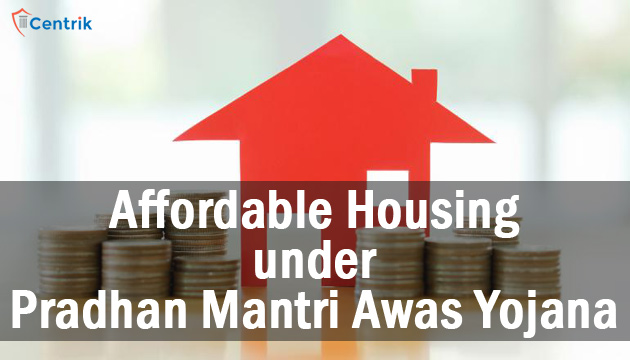
For quite many of us the phrase “affordable housing” might sound like just a dream, in present age of exorbitant houses that expand the costs for most of us. Certainly, purchasing our own house can take a considerably long period of time. Nevertheless, beyond highly priced extravagant luxury homes in the metro cities of India, a new wave is sweeping India’s reality sector, “ Affordable housing for all, the Narendra Modi government’s plans aimed at housing for the masses, could indeed change the face of home ownership in India.
Till a year prior what bothered Anshu Pathak most about her leased house was, sharing the 28 sq. ft. washroom with three different families. Inside the house there was no space or security and outside there was no sheltered place for her kids to play.
Prime Minister Modi’s ‘Housing for All’ program, which conceives development of 1 crore houses will transformatively affect any semblance of Anshu. It is additionally a Rs. 10 lac crore market opportunity, a heft of which will be produced by private industry prompting more noteworthy tax collection. Enterprises connected to housing, for example, housing finance, development and manufacture of housing materials will remain to pick up. Given how labour-intensive construction is (utilizing just about 7% of India’s workforce) and that most construction materials are made domestically, ‘Make in India’ and Skill India’ missions will likewise be beneficial.
A key test is approvals. Indeed, even projects falling inside private zone of a city’s master plan may not get approvals because of scores of factors for which no data is publicly accessible (e.g., government’s yo-yoing road widening plans or on-paper presence of an invisible water-body). To abstain from being saddled with undevelopable land, builders utilize 100-point checklist as a component of their due-diligence but keep running into years of postponements before receiving approvals.
For optimizing approvals digitization of land records is in this manner critical however is itself a tedious task. For speedier outcomes, enabled committees should be set up containing delegates of every department that awards approvals and charged of unblocking approval obstacles that slow down tasks and notifying construction-ready prepared lands in each state.
Incomprehensibly, sales, which is a component of aggregating demand is likewise a challenge in EWS/LIG housing. Buying a home is the greatest choice in the life of a low-income purchaser and consequently a tedious task, including process that involves him visiting the venture several times, consulting with the more family, checking his loan eligibility and lastly clobbering together the down payment for the home. Client acquisition is hence a long and expensive issue.
For the standard acquisition time and cost of a single middle class customer, the designer must procure a several low-income customers. Cancellation rates moreover are generally higher in this segment on account of the customer’s failure to plan finances or to assimilate unexpected financial shocks. Numerous EWS/LIG clients are regularly likewise un-bankable in spite of the huge number of new money flush non-managing financial companies (NBFCs) in the market.
Granting government offices and PSUs that encourage the most number of house purchases from among their workers (right now 2.15 crore are utilized) would drive the pace of sales and in this way construction of homes.
Different studies have shown that the government’s deep rooted model of public-private partnerships where the land belongs to the state, construction is outsourced to a private contractor and allotments are regulated by the state, has met with little achievement since no one’s incentives are lined up with that of the customers. For one, in light of the fact that the contractual worker does not need to confront the post-ownership music from the allottees, the nature of construction is frequently sub-standard.
Government ought to just auction state-claimed land to privately owned companies that will design, develop and offer EWS/LIG homes on market lines. Implementation of Real Estate (Regulation and Development) Act, 2016 (RERA) will consequently guarantee conformity to the auction conditions.
Permitting 90% withdrawal from EPFO accounts for home buy and the credit-connected subsidy of upto Rs.2.67 lacs are magnificent measures to connect affordability. Notwithstanding, paying for a house that exists just on paper isn’t simple for EWS/LIG purchasers. To make constructed homes government can expand construction finance loan for a long time on a moving premise at reduced rates of 6% to designers building just EWS/LIG homes. Also, a ban of three years from the date of RERA registration to pay the approval fee will enormously diminish the upfront equity trouble making the economics of the model more appealing.
AT present, Anshu is the glad proprietor of a two-room house that she acquired for Rs. 8.5 lacs in Shubhashray’s gated estate in Bhiwadi, Rajasthan. On her spouse’s monthly income of Rs.18000 she can manage the cost of the Rs. 4,500 EMI (post-appropriation). Her children spend the day at the close-by school and afterward at the recreation park inside the premises, giving her a lot of time to figure out how to utilize a PC at the colony’s learning focus.
At long last, for the middle class to lower income classes, the Pradhan Mantri Awas Yojana gives a noteworthy chance to their dream to own a home. This dream could well be nearer to reality.
Note – Please note that the above article is for education purpose only. This is based on our interpretation of laws which may differ person to person. Readers are expected to verify the facts and laws.




 join For Updates
join For Updates